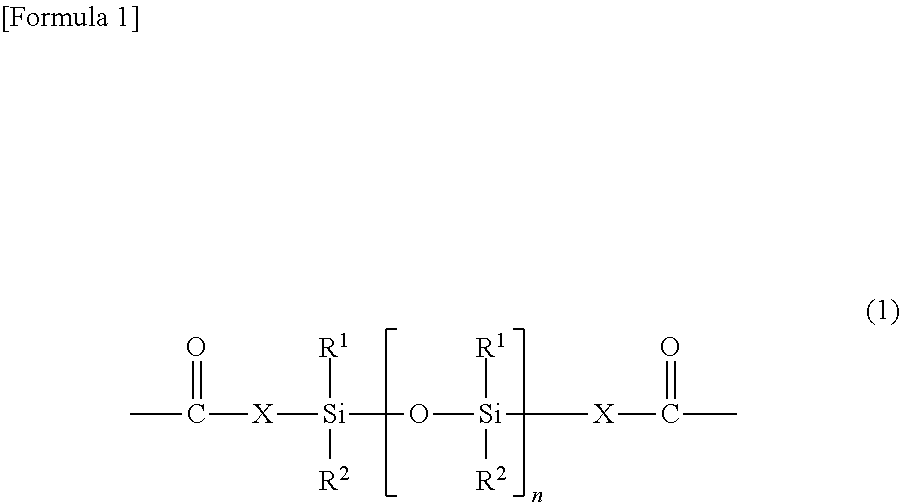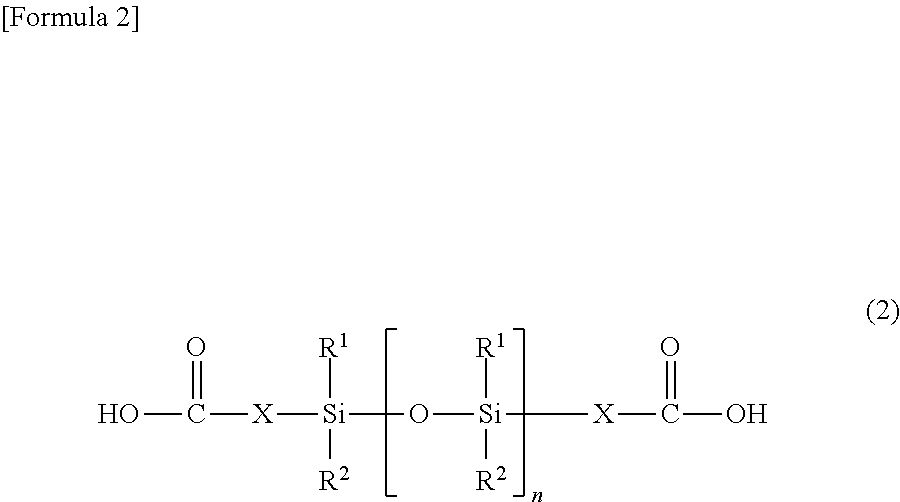Polycarbonate-Polysiloxane Copolymer, and Method for Preparing Same
- Summary
- Abstract
- Description
- Claims
- Application Information
AI Technical Summary
Benefits of technology
Problems solved by technology
Method used
Image
Examples
example 1
[0044]2 L of methylene chloride and 1 L of distilled water are filled in a reactor, and methyltributylammonium chloride (15.2 g) is added thereto. To the solution is added the siloxane polymer (112.7 g) represented by Formula 2-1 wherein m is 8 and n is 40. Thereafter, a solution of triphosgene (13.4 g) in 0.5 L of methylene chloride is further added to the reactor with vigorous stirring, and then a NaOH solution is added to maintain a pH of 4-7. The temperature is maintained at 20-25° C. After the pH is stably maintained at 4-7 by the addition of the NaOH solution, 1 L of methylene chloride and 0.5 L of distilled water are further added, followed by the addition of a solution of triethylamine (10.0 g) in 0.25 L of methylene chloride. Thereafter, 2,2-bis(4-hydroxyphenyl)propane (BPA) (228.3 g) and triphosgene (108.8 g) are added to the reactor, and then a NaOH solution is added to maintain a pH of 10-11. The temperature is maintained at 20-25° C. After the pH is stably maintained at...
example 2
[0045]The procedure of Example 1 is repeated, except that the siloxane polymer (116.5 g) of Formula 2-1 wherein m is 12 and n is 40 is added. DOSY analysis of the final polymer reveals the presence of the silicone polymer bonded to (incorporated into) the main chain of the polycarbonate. The polymer is found to have a Si content of 2.28 wt % by 1H NMR analysis and to have a Mw of 22,206 g / mol by GPC analysis.
example 3
[0046]The procedure of Example 1 is repeated, except that the siloxane polymer (131.5 g) of Formula 2-1 wherein m is 8 and n is 40 is added. DOSY analysis of the final polymer reveals the presence of the silicone polymer bonded to (incorporated into) the main chain of the polycarbonate. The polymer is found to have a Si content of 2.85 wt % by 1H NMR analysis and to have a Mw of 21,634 g / mol by GPC analysis.
PUM
| Property | Measurement | Unit |
|---|---|---|
| Temperature | aaaaa | aaaaa |
| Fraction | aaaaa | aaaaa |
| Fraction | aaaaa | aaaaa |
Abstract
Description
Claims
Application Information
 Login to View More
Login to View More - Generate Ideas
- Intellectual Property
- Life Sciences
- Materials
- Tech Scout
- Unparalleled Data Quality
- Higher Quality Content
- 60% Fewer Hallucinations
Browse by: Latest US Patents, China's latest patents, Technical Efficacy Thesaurus, Application Domain, Technology Topic, Popular Technical Reports.
© 2025 PatSnap. All rights reserved.Legal|Privacy policy|Modern Slavery Act Transparency Statement|Sitemap|About US| Contact US: help@patsnap.com



